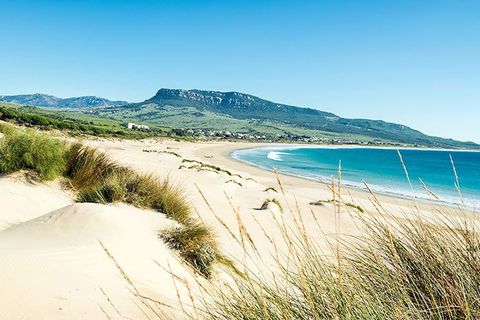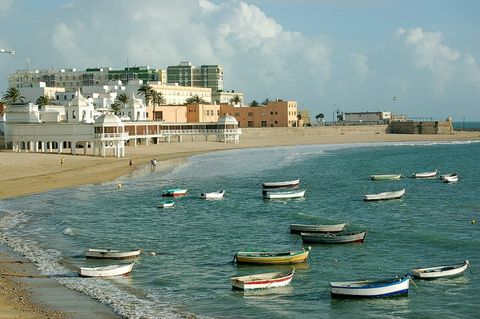BEACHES - LOCAL AND A LITTLE FURTHER AFIELD
It’s long been a secret amongst Spanish visitors, that the long golden sandy beaches on Cadiz’s Costa de la Luz are some of the very best in Spain!
LOCAL
TARIFA & TO THE SOUTH
Bolonia – one of the most beautiful beaches of fine sand with rock pools in the area (20 mins drive on the N340, about 6 miles before Tarifa), flanked by dunes and pine forests. You can see Morocco on a clear day from this beach of fine, pale sand, and swinds combined with quite small waves make this part of the coast ideal for windsurfing and kitesurfing. Bolonia is more sheltered than the stretch farther south towards Tarifa, making it more suitable for sunbathing too.
There is a Roman settlement, Baelo Claudia, at one end of the beach, complete with the remains of a fish-salting factory, temples and baths. The museum is small but interesting, free to EU visitors.
Try Bolonia or Los Troncos (0034 956 688533), both right on the beach, for locally caught fried fish. La Cabaña is the perfect shack for cold beers. In Bolonia village, Las Rejas (Calle Lentiscal 8, 0034 956 688546) serves fabulous fish stews.
Valdevaqueros – just North of the old port town of Tarifa, this beach with its huge sand dune is the centre for kitesurfing on the Costa de la Luz and ideal for windsurfing too. Several little beach bars and a good restaurant with shade for lunch.
Punta Paloma - this is the name of the headland just to the north of Tarifa that separates the expansive beaches of Tarifa from those of Bolonia. Playa Punta Paloma itself is an unspoiled paradise beach, so seek out this series of beautiful, protected inlets - not least as there is a mud found on the beach, which apparently has similar skin-revitalising qualities for which one pays a fortune in spas!
Tarifa, Playa Chica – just for sunbathers, great for families with showers, toilets & sunshades. Explore the winding streets and alleys in the old port town below the walls, with a great range of restaurants, cafes and shops to suit all tastes with vegetarian and vegans particularly catered for here. Tarifa can be very windy, as you can tell from the kitesurfing - but there are also day trips to Morocco via the seacat and whale & dolphin trips from the harbour too!
CADIZ & TO THE NORTH
Conil de la Frontera -
Playa La Fontanilla-
once a small fishing town, this is now a busier town with a lovely older centre filled with boutiques and other shops. Very popular with Spanish visitors, the huge golden sandy beach itself is located just to the west of the town with surf, but still family friendly. The beach is flanked by a number of restaurants that sit beside the sand, so good for families with teenagers who want more than sitting on a beach without the crowd.
Calas de Poniente. A cala is an area enclosed by cliffs, so unsurprisingly these seven beaches are more like hidden coves. They aren’t the easiest to access (nor too difficult), but with no eating options take a picnic and expect to have plenty of space to yourself. Note: If you want to get back to nature these beaches are nudist, but many wear some clothing - so it is optional!
La Barossa – more of a laid-back beach resort rather than a town like nearby Chiclana de la Frontera, it is backed by a promenade with restaurants on one part, the other is undeveloped. The 8km beach is very popular with the Spanish, with plenty of water sports facilities, as well as a selection of bars and restaurants along the promenade in front of low rise apartments. There are also a couple of music bars which stay open until late.
Cadiz town - spend some time exploring the old town of Cadiz with a lazy lunch, before relaxing on the beach in the afternoon. La Caleta is more of a local family oriented beach in the city center and La Victoria is a long and wide beach along the main avenue of the city, with carnival parades at different times of the year.
Valdelgrana
– is located along the West/Atlantic side of the narrow neck land that joins Cadiz to the coast. It is one of the most popular (and commercial) beaches with the Spanish, with a park for kids too. Its size and wind conditions make it ideal for water sports like windsurfing or kite-surf, as well as pedalos to hire too. It provides access for the disabled through gateways installed along the beach, as well as seating and bathing facilities too.


